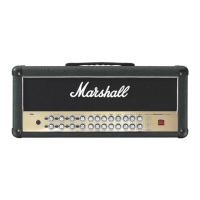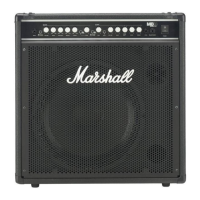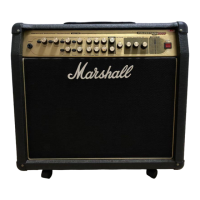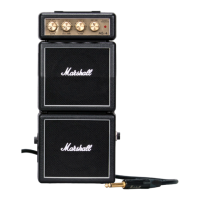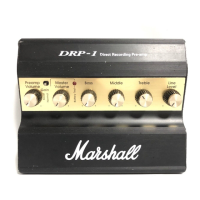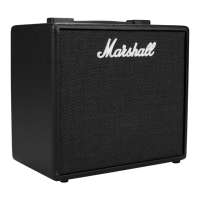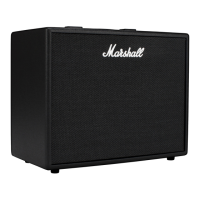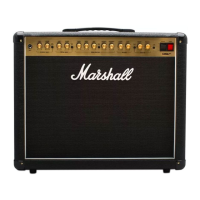ENGLISH
4
ENGLISH
5
1. Mains Input
Plug the mains power cord provided in here
2. Footswitch Jack Socket
For connection to the supplied remote footswitch
which provides switching of both internal and
external effects.
3. Effects Send
Sends the signal from the AS100D to the input of
an external effects processor.
4. Effects Level Control
Rotary control to adjust the external effects return
level.
5. Stereo Effects Return
Left (mono) and Right returns to accept the output
from an external effects processor. If the
processor is mono (such as a floor pedal),
connect to the left (mono) return jack.
6. D.I. Outputs
Left and right direct outputs, fully balanced for
connection to external PA mixing desk.
7. Line Out
Unbalanced Left and right direct outputs for
connection to recording or other outboard
equipment.
Channel 2 - Acoustic Instrument and
Microphone
9. Instrument Input
Mono jack input. Plug the lead from your guitar in
here to connect to channel 2 only.
10. Microphone Input
XLR type socket to connect a microphone to
channel 2.
11. Link Channel 1 Switch
Switch to link channel 2 (when an instrument with
a single stereo jack is connected) to the stereo
Input of channel 1 (see item 1). Channel 2 level
and EQ settings will affect the signal connected to
the ring of the stereo input jack. (item 1). Refer to
block diagram.
12. Contour Switch
Changes the contour of the channel EQ by cutting
the Mid by a predetermined amount.
13. Phantom Switch
If you require Phantom power for your condenser
microphone, pressing this switch provides +15V.
14. Phase Switch
Reverses the phase of the signal to cut out
unwanted resonances caused by the instrument
and speakers being in phase. This can
considerably reduce the amount of low frequency
acoustic feedback.
Ensure that you test this in the position where you
will actually perform.
15. Volume Control
Adjusts the volume level of channel 2.
16. Bass Control
Adjusts the amount of bottom end or bass in your
sound. Too much bass can cause unwanted feed
back, therefore care should be taken when setting
this control. The best position to start is 12
o’clock, then adjust from there as desired.
17.Treble Control
Adjusts the high end or treble frequencies in your
tone. Again, care should be taken when setting
this control as too much treble will cause high
pitched feedback. The starting point of the 12
o’clock position is best.then adjust from there to
suit your own preference.
Channel 1 and Channel 2 mix
Anti Feedback Section.
18. ‘On’ Switch
Activates the Anti Feedback filters (items 21 & 22)
for both acoustic instrument channels.
19. Depth Switch
Increases the depth for both notch filter controls
20 & 21.
20. Rotary Feedback Filter (Sweep 1)
Sweeps the band of frequencies most likely to
cause body resonance (the main offending
feedback frequencies) from 50Hz - 250Hz and
reduce it when selected.
21. Rotary Feedback Filter (Sweep 2)
Provides a second sweep of a broader band of
frequencies (60Hz - 650Hz) to help remove the
second offending frequency.
TIP: In order to select and eliminate the offending
frequencies, select the point where the feedback just
appears and move the frequency control until it
disappears. Next, increase the gain level until the
feedback reappears and adjust the frequency again,
then back off the level slightly.
Channel 1 and Channel 2 mix
Effects Switches
22. Internal Effects Switch
Activates the internal stereo digital effects section
for the acoustic instrument channels.
23. External Effects Switch
Activates the external effects loop for the acoustic
instrument channels.
Channel 3 - Microphone
24. Microphone Input
XLR type socket to take the input from an external
microphone for either vocal or instrument
reproduction.
25. Phase Switch
Reverses the phase of the signal to cut out
unwanted resonances caused by the instrument
and speakers being in phase.
26. Phantom Switch
If you require Phantom power for your condenser
microphone, pressing this switch provides +15V.
AS100D Front Panel Features
AS100D Rear Panel Features
AS100D Front Panel Features
27. Volume Control
Adjusts the volume level of channel 3.
28. Bass Control
Adjusts the amount of bottom end or bass in your
sound. Too much bass can cause unwanted feed
back, therefore care should be taken when setting
this control. The best position to start is 12
o’clock, then adjust from there as desired.
29. Treble Control
Adjusts the high end or treble frequencies in your
tone. Again, care should be taken when setting
this control as too much treble will cause high
pitched feedback. The starting point of the
12 o’clock position is best, then adjust from there
to suit your own preference.
30. Internal Effects Mix Control
Selects the amount of effect from the built in
digital effects for channel 3 only.
31. External Effects Mix Control
Selects the amount of effect on channel 3 from
any external effects processor connected through
the FX Loop.
Channel 4 - Auxiliary
32. Phono Inputs
Left and right phono sockets for connection to
CD/MD/Tape player, Drum Machine or other
backing equipment. This channel works in stereo.
33. Volume Control
Controls the volume level of the auxiliary channel.
Stereo Digital Effects
34. Program Select Control
Rotary control to select one of the 16 digital
effects programs.
35. Parameter Adjust Control
Adjusts the main parameter of the effect selected
by Program Select Control (item 34). The main
parameter is decay time for all Reverb and Delay
programs. For Chorus, Flange and Modulation
programs, it is the Speed.
36. Effects Level Control
Controls the amount of the digital effects signal in
the mix.
Master Volume
37. Master Volume Control
Controls the overall volume level of the AS100D.

